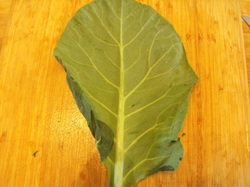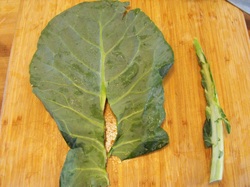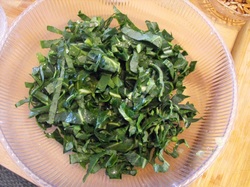Valentine’s Day has passed but we need to continue to think about our hearts. February is Heart Health Awareness month and according the American Heart Association (www.heart.org), 90% of the women in America have one or more risk factors for developing heart disease. With that staggering statistic, it is easy to realize that we need to watch what we eat and include more of the right choices in our diet. Less cholesterol, the right type of fat, fresh leafy green vegetables, nuts, fiber, and many other obvious choices can help turn things in the right direction. Be certain, however, that when you do make these choices one does not cancel out the other. Having a generous helping of a fresh vegetable that was over-cooked and heavily seasoned is an excellent example of our tendency to self-defeat.
When you hear “collards”, most people think of the overcooked, slightly slimy greens that I thought my grandmother cooked far too often when I was a kid. These dark green leaves were often covered with sand when harvested and seemed to require a ton of work to wash, chop, and cook for what seemed to take hours (all while releasing a less than pleasant aroma). I can still remember the time grandma tried washing them in the washing machine (on cold, without detergent) and the tricks we tried to reduce their fragrance while cooking (putting a pecan in the cooking water). No matter how you made them, they were a smelly chore.
My original home town is Ayden, North Carolina, and their great claim to fame IS the collard festival. When I was very young, I dreamt of some day being crowned the “Collard Queen,” but I had no desire to eat the things. There in Ayden, our collards were prepared in true “soul food” fashion with lots of bacon grease, or a streak of lean or fat back. Though some people did love them this way, they could not for a moment be considered “heart healthy”.
The sad reality is that after all of that stewing and brewing, the collards lost much of their original integrity as a vegetable. Instead, they ended up as a sponge for high fat, high cholesterol seasoning. I have found that I far prefer the fresh, crisp, sweet flavor of uncooked collards. They make an excellent base for a salad. This recipe can be quickly tossed together for a delicious and easy side dish that is NOTHING like the collards of my youth. If at all possible, choose fresh, young, tender leaves that are picked locally. You need to chop the leaves yourself for the maximum fresh, sweet flavor and the most nutrients. But be forewarned, this recipe did almost give my grandmother a heart attack. Like many here in the South, she could not believe that collards can be eaten this way, but even she endorses this recipe now!
Collard Salad
Prep Time: 10 minutes
Cook Time: 10 minutes
20 minutes
Number of servings: 4
Per Serving 159 calories
Fat 13 g
Carbs 11 g
Protein 3 g
Collards don’t have to be over-cooked, soggy greens. Enjoy this fresh alternative and let them surprise you.
Ingredients
Directions
Place chopped collard greens in a large salad bowl.
Top with apple, pecans, and green onion.
Drizzle with vinegar, toss. Drizzle with olive oil, toss. Add pepper, if desired, and enjoy.






